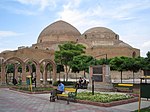Qara Qoyunlu
|
Kara Koyunlular
|
|||||||||
|---|---|---|---|---|---|---|---|---|---|
Tên bản ngữ
| |||||||||
| 1375–1468 | |||||||||
|
Quốc kỳ | |||||||||
 Qara Qoyunlu của người Turkoman, màu xanh nhạt cho thấy cương thổ rộng lớn nhất ở Iraq và bờ đông bán đảo Ả Rập trong một khoảng thời gian ngắn | |||||||||
| Tổng quan | |||||||||
| Thủ đô | Tabriz | ||||||||
| Ngôn ngữ thông dụng | Tiếng Ả Rập Armenia Azerbaijan (thơ ca)[1] Thổ Oghuz Ba Tư (thơ ca)[1] | ||||||||
| Tôn giáo chính | Islam[2] | ||||||||
| Chính trị | |||||||||
| Chính phủ | Quân chủ | ||||||||
| Vua | |||||||||
• 1375–1378 | Bayram Xoca | ||||||||
• 1467–1468 | Hasan 'Ali | ||||||||
| Lịch sử | |||||||||
| Thời kỳ | Trung Cổ | ||||||||
• Thành lập | 1375 | ||||||||
• Giải thể | 1468 | ||||||||
| |||||||||
| Hiện nay là một phần của | |||||||||
Kara Koyunlu hay Qara Qoyunlu, hay còn được gọi là Tộc Cừu Đen (tiếng Ba Tư: قره قویونلو) (Tiếng Azerbaijan : Qaraqoyunlular) là một liên minh bộ lạc người Thổ Oghuz theo đạo Hồi giáo Shia[3] đã cai trị ở vùng đất mà ngày nay là Azerbaijan, Armenia (1406), tây bắc Iran, miền đông Thổ Nhĩ Kỳ, và đông bắc Iraq từ 1375 đến 1468.[4][5]
Một số nhà nghiên cứu liên kết phương ngữ Oguz của Kara-Koyunlu với ngôn ngữ Azerbaijan. Ví dụ, Faruk Shumer lưu ý rằng phương ngữ Đông Oguz của Kara-Koyunlu ngày nay được gọi là ngôn ngữ Azerbaijan,[6] Muhsin Behramnejad gọi ngôn ngữ Azerbaijan là di sản được thừa hưởng từ các bộ lạc Kara-Koyunlu thuộc tộc người Turkoman. Sultan Kara-Koyunlu năm 1435-1467 Jahanshah là một đại diện được công nhận chung của thơ ca Azerbaijan[5][7]
Kiến trúc
[sửa | sửa mã nguồn]Tham khảo
[sửa | sửa mã nguồn]- ^ a b Minorsky 1954, tr. 283.
- ^ Quiring-Zoche, R. “AQ QOYUNLŪ”. Encyclopedia Iranica. Truy cập ngày 29 tháng 10 năm 2009.
The argument that there was a clear-cut contrast between the Sunnism of the Āq Qoyunlū and the Shiʿism of the Qara Qoyunlū and the Ṣafawīya rests mainly on later Safavid sources and must be considered doubtful.
- ^ Elgood 1995, tr. 114.
- ^ Hovanissian 2004, tr. 4.
- ^ a b Encyclopædia Britannica. "Kara Koyunlu". Online Edition, 2007
- ^ M. Faruk Sümer, «Kara Koyunlular», s. VIII: (Turkish) Kara-Koyunlular Anadolu'dan Iran'a vuku bulan bu siyasi göç hareketlerinin müsebbibi oldukları gibi, aynı zamanda Iran'da yeniden Türkmen hâkimiyetinin başlamasının ve bununla alâkah olarak da Arerbaycan'ın kat'i bir surette türkleşmesini temin edecek yeni bir iskan hareketinin ilk âmili de olmuşlardır. Bu sözlerden de anlaşlıacağı üzere, onların konuştukları türkçe, tabil bugün Azeri lehçesi denilen doğ Oguz veya Türkmen lehçesi idi. Kara-Koyunlu hükümdarlarından Cihan-Sah'ın Azeri edebiyatının mümessillerinden biri oldugu bugün kat'i olarak anlaşılmıştır.
- ^ V. Minorsky. Jihān-Shāh Qara-Qoyunlu and His Poetry (Turkmenica, 9). Bulletin of the School of Oriental and African Studies, University of London. — Published by: Cambridge University Press on behalf of School of Oriental and African Studies, 1954. — V.16, p . 272, 283: «It is somewhat astonishing that a sturdy Turkman like Jihan-shah should have been so restricted in his ways of expression. Altogether the language of the poems belongs to the group of the southern Turkman dialects which go by the name of Azarbayjan Turkish.»; «As yet nothing seems to have been published on the Br. Mus. manuscript Or. 9493, which contains the bilingual collection of poems of Haqiqi, i.e. of the Qara-qoyunlu sultan Jihan-shah (A.D. 1438—1467).»
Nguồn sách
[sửa | sửa mã nguồn]- Bosworth, Clifford E. (1996). The New Islamic Dynasties. Columbia University Press.
- Kouymjian, Dickran (2004). “Armenia from the fall of the Cilician Kingdom (1375) to the forced emigration under Shah Abbas”. Trong Hovannisian, Richard G. (biên tập). The Armenian People From Ancient to Modern Times, Volume I: The Dynastic Periods: From Antiquity to the Fourteenth Century. Palgrave Macmillan. ISBN 978-1-4039-6421-2.
- Minorsky, V. (1954). “Jihān-Shāh Qara-Qoyunlu and His Poetry (Turkmenica, 9)”. Bulletin of the School of Oriental and African Studies. 16 (2): 271–97. doi:10.1017/s0041977x00105981. JSTOR 609169.
- Quiring-Zoche, R. (29 tháng 10 năm 2009). “AQ QOYUNLŪ”. Encyclopedia Iranica.
- Quiring-Zoche, R. (1986). “Āq Qoyunlū”. Encyclopædia Iranica, online edition, Vol. II, Fasc. 2. New York. tr. 163–168.
- Roemer, H. R. (1986). “The Turkmen dynasties”. Trong Lockhart, Laurence; Jackson, Peter (biên tập). The Cambridge History of Iran, Volume 6: The Timurid and Safavid Periods. Cambridge: Nhà xuất bản Đại học Cambridge. ISBN 0-521-20094-6.
- Savory, R. M. (2009). “The Struggle for Supremacy in Persia after the death of Tīmūr”. Der Islam. De Gruyter. 40: 35–65. doi:10.1515/islm.1964.40.1.35. S2CID 162340735.




